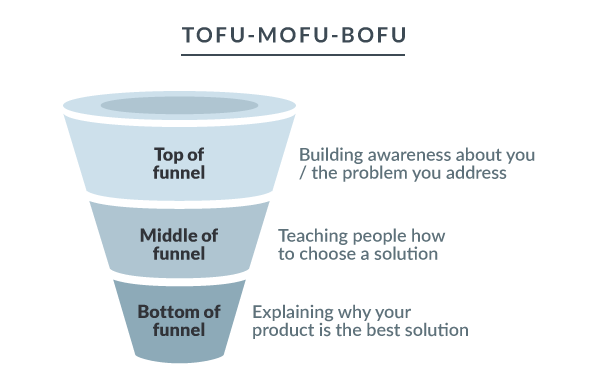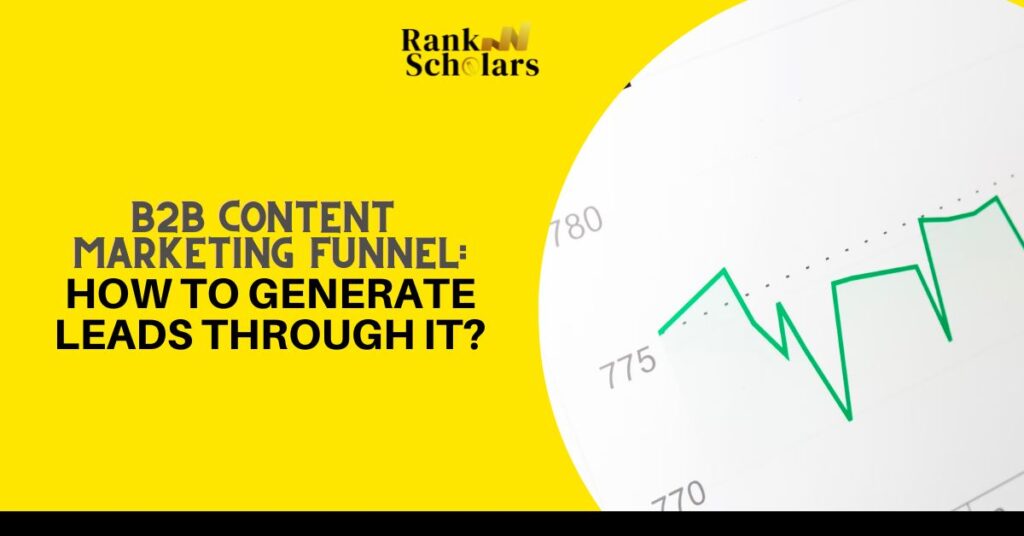Are you struggling to generate leads and sales for your B2B business?
If so, you’re not alone. Many B2B marketers face this challenge. But there is a solution: a well-crafted B2B content marketing funnel.
A B2B content marketing funnel is a framework that guides you in creating content tailored to each stage of the buyer’s journey. By understanding your target audience’s pain points and creating content that addresses them, you can attract, engage, and convert more leads into paying customers.
In this blog post, we’ll discuss everything you need to know about creating a B2B content marketing funnel which will help you achieve your business goals.
What Is a B2B Content Marketing Funnel?

A B2B content marketing funnel is a strategic framework that guides potential customers through a journey, from their initial awareness of your product or service to the final purchasing decision. It’s a process that involves nurturing leads and addressing their pain points at 3 different stages of the funnel.
- Top of the funnel (TOFU): This stage focuses on creating awareness among your target audience, showcasing your expertise, and addressing common pain points of B2B companies.
- Middle of the funnel (MOFU): Here, potential customers are considering your product or service. Content may include case studies, whitepapers, and eBooks to provide in-depth information.
- Bottom of the funnel (BOFU): At this stage, leads are close to making a purchasing decision. Content should emphasize the unique value proposition and offer opportunities like free trials.
B2B vs B2C Content Marketing Funnel: What’s the Difference?
The main difference between B2B and B2C content marketing funnels is the length of the buying cycle. B2B buyers typically have a longer buying cycle than B2C buyers. This means that they need more time to learn about your products or services and make a decision.
As a result, your B2B content marketing funnel should be longer and more detailed than your B2C content marketing funnel. You need to provide potential customers with the information they need to make an informed decision.
While in B2C, the emphasis is on immediate conversions, often involving discounts, promotions, and emotional appeals.
Why Should You Create a B2B Content Marketing Funnel?
There are several benefits to creating a B2B content marketing funnel:
-
Increased Brand Awareness
By creating high-quality content that is relevant to your target audience, you can increase brand awareness and attract new potential customers.
-
Lead Generation
Your content can be used to generate leads by providing potential customers with valuable information and resources.
-
Sales Opportunities
Your content can be helpful in nurturing leads and moving them down through the sales funnel.
-
Customer Loyalty
By providing excellent content and support, you can build customer loyalty and encourage repeat business. Retaining old customers is way easier than getting new ones. And happy customers can also provide you with referrals.
-
Data-Driven Decisions
Funnel analytics provide insights into where potential customers might be dropping out of the funnel, enabling you to make data-driven improvements. Based on this, you can tweak your strategy and generate better results.

5 Steps to Create a B2B Content Marketing Funnel for Your Business
Below is a 5-step process using which you can create a B2b content marketing funnel and generate leads for your business.
1. Define Your Target Audience
Who are you trying to reach with your content? What are their pain points? What are their needs and interests? You must understand your audience’s well. Here’s how can you:
- Create buyer personas: Buyer personas are fictional representations of your ideal customers. They help you understand your target audience’s needs, pain points, and goals.
- Research your target audience: Conduct market research to learn more about your target audience’s demographics, interests, and behaviors.
- Analyze your customer data: If you have existing customer data, analyze it to identify trends and patterns.
2.Map Out Your Buyer’s Journey
How do your target customers learn about and evaluate potential solutions? Learn it here:
- Identify the different stages of the buyer’s journey: The buyer’s journey is the process that potential customers go through when they are considering a purchase. It typically includes the following stages: awareness, consideration, decision, and post-purchase.
- Understand the needs and interests of your target audience at each stage of the buyer’s journey: What are they looking for? What information are they seeking? What are their pain points?
- Identify the key touchpoints that your target audience encounters at each stage of the buyer’s journey: This could include your website, social media, email marketing, and paid advertising.
3. Create Content for Each Stage of the Funnel
Your content should be tailored to the specific needs and interests of your target audience at each stage of the buyer’s journey. Use case studies, whitepapers, and expert insights to showcase your expertise. We’ll talk about this in detail.
4. Promote Your Content
Make sure your content is easy to find and share.
- Use social media: Share your content on social media platforms where your target audience is active.
- Use email marketing: Send your content to your email subscribers.
- Use paid advertising: Run paid advertising campaigns on search engines and social media platforms.
5. Track Your Results
Track your results to see what’s working and what’s not. This will help you improve your content marketing strategy over time. Here’s how to:
- Use analytics tools: Track your website traffic, social media engagement, and email open rates.
- Use lead generation tools: Track the number of leads you generate from your content marketing efforts.
- Use sales CRM software: Track the number of sales that are closed as a result of your content marketing efforts.
How to Create Content for Your B2B Content Marketing Funnel?
Here are some tips for creating content for each stage of the B2B content marketing funnel:
Top of the Funnel
- Blog posts: Write blog posts that introduce your target audience to your products or services and address their pain points.
- eBooks: Create eBooks that provide in-depth information on a specific topic that is relevant to your target audience.
- Infographics: Create infographics that visually represent complex information in a way that is easy to understand.
Middle of the Funnel
- Case studies: Share case studies that demonstrate how your products or services have helped other businesses solve their problems.
- Whitepapers: Create whitepapers that provide detailed information on a specific topic that is relevant to your target audience.
- Webinars: Host webinars where you can share your expertise and answer questions from your target audience.
Bottom of the Funnel
- Free trials: Offer free trials of your products or services so that potential customers can try them out before they buy.
- Demos: Give demos of your products or services so that potential customers can see how they work.
- Testimonials: Share testimonials from satisfied customers to build credibility and trust.
Bonus Tips for Creating a Successful B2B Content Marketing Funnel
Here are 3 additional tips to help you succeed with a B2B content marketing funnel.
- Make sure your content is high-quality and informative. Your content should be well-written and easy to understand. It should also be relevant to your target audience and address their pain points.
- Promote your content consistently. You need to be consistent with your content marketing efforts in order to see results.
- Track your results and make adjustments as needed. It’s important to track your results so that you can see what’s working and what’s not. This will help you improve your content marketing strategy over time.
If you’re looking for help creating a B2B content marketing funnel, Rank Scholars can help. We have a team of experienced content marketing professionals who can help you develop a customized strategy that meets your specific needs.
FAQs
Content Marketing Funnel FAQs






